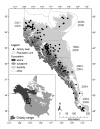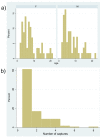Environmental, biological and anthropogenic effects on grizzly bear body size: temporal and spatial considerations
- PMID: 24010501
- PMCID: PMC3849066
- DOI: 10.1186/1472-6785-13-31
Environmental, biological and anthropogenic effects on grizzly bear body size: temporal and spatial considerations
Abstract
Background: Individual body growth is controlled in large part by the spatial and temporal heterogeneity of, and competition for, resources. Grizzly bears (Ursus arctos L.) are an excellent species for studying the effects of resource heterogeneity and maternal effects (i.e. silver spoon) on life history traits such as body size because their habitats are highly variable in space and time. Here, we evaluated influences on body size of grizzly bears in Alberta, Canada by testing six factors that accounted for spatial and temporal heterogeneity in environments during maternal, natal and 'capture' (recent) environments. After accounting for intrinsic biological factors (age, sex), we examined how body size, measured in mass, length and body condition, was influenced by: (a) population density; (b) regional habitat productivity; (c) inter-annual variability in productivity (including silver spoon effects); (d) local habitat quality; (e) human footprint (disturbances); and (f) landscape change.
Results: We found sex and age explained the most variance in body mass, condition and length (R(2) from 0.48-0.64). Inter-annual variability in climate the year before and of birth (silver spoon effects) had detectable effects on the three-body size metrics (R(2) from 0.04-0.07); both maternal (year before birth) and natal (year of birth) effects of precipitation and temperature were related with body size. Local heterogeneity in habitat quality also explained variance in body mass and condition (R(2) from 0.01-0.08), while annual rate of landscape change explained additional variance in body length (R(2) of 0.03). Human footprint and population density had no observed effect on body size.
Conclusions: These results illustrated that body size patterns of grizzly bears, while largely affected by basic biological characteristics (age and sex), were also influenced by regional environmental gradients the year before, and of, the individual's birth thus illustrating silver spoon effects. The magnitude of the silver spoon effects was on par with the influence of contemporary regional habitat productivity, which showed that both temporal and spatial influences explain in part body size patterns in grizzly bears. Because smaller bears were found in colder and less-productive environments, we hypothesize that warming global temperatures may positively affect body mass of interior bears.
Figures



References
-
- Forchhammer MC, Clutton-Brock TH, Lindström J, Albon SD. Climate and population density induce long‒term cohort variation in a northern ungulate. J Anim Ecol. 2001;70:721–729. doi: 10.1046/j.0021-8790.2001.00532.x. - DOI
-
- Elton C. Animal ecology. London: Macmillan; 1927.
-
- Andren H. Corvid density and nest predation in relation to forest fragmentation: A landscape perspective. Ecology. 1992;73:794. doi: 10.2307/1940158. - DOI
Publication types
MeSH terms
LinkOut - more resources
Full Text Sources
Other Literature Sources

